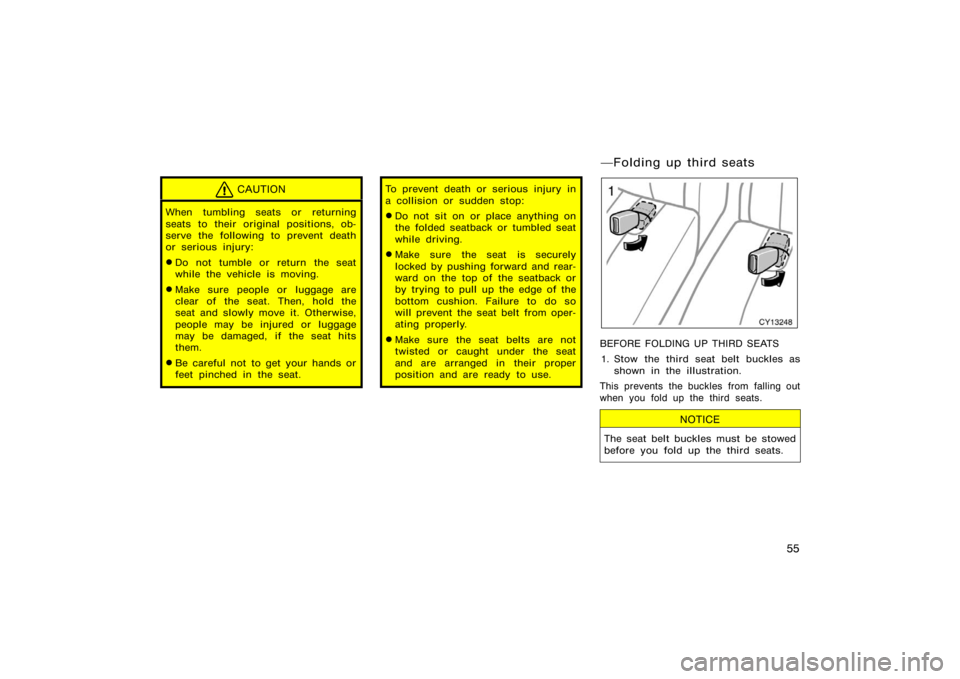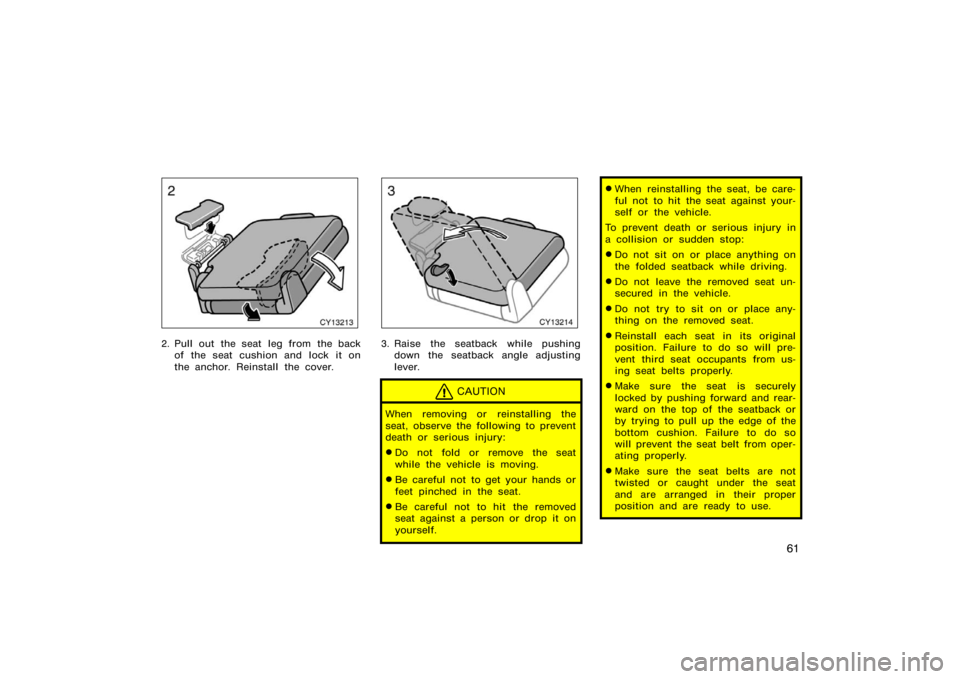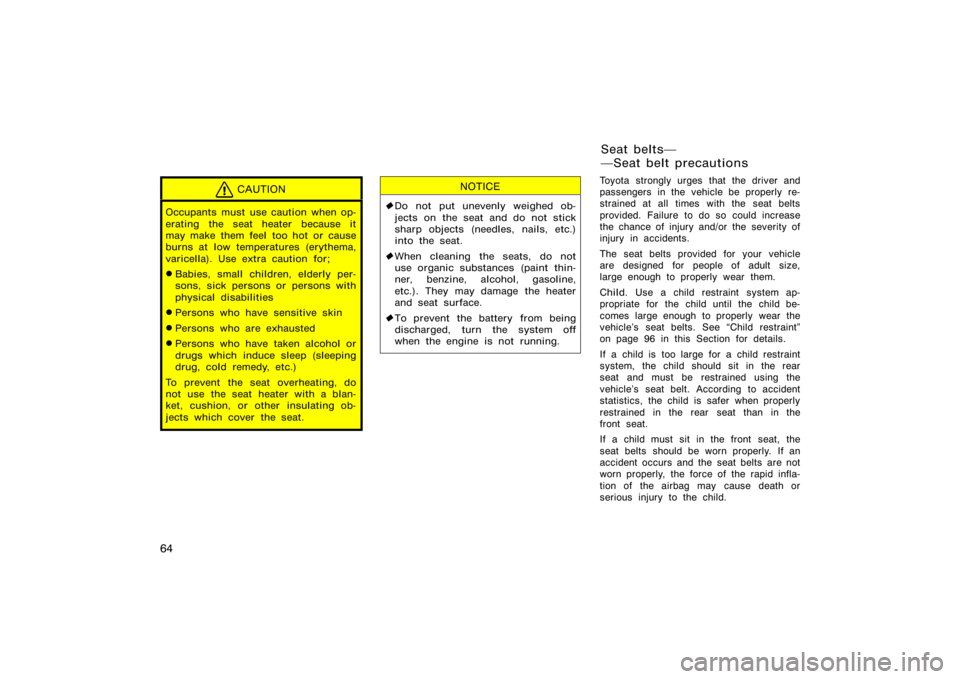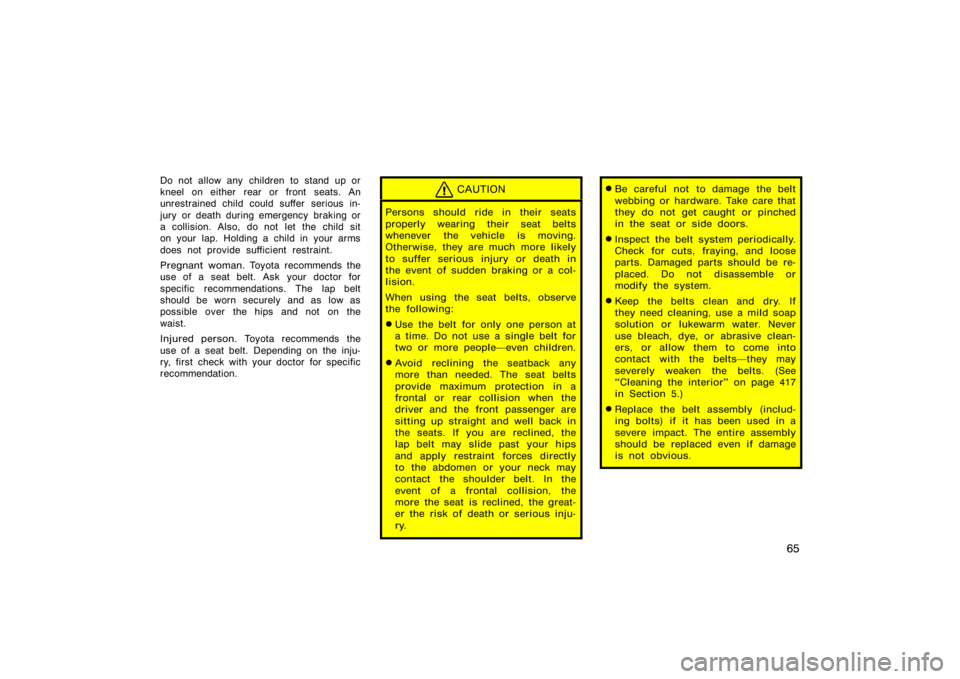Page 65 of 496
53
CY13199
Second seats
CY13204
Third seats
SEATBACK ANGLE ADJUSTING LEVER
Lean forward and pull the lock release
lever. Then lean back to the desired
angle and release the lever.
CAUTION
Avoid reclining the seatback any
more than needed. The seat belts pro-
vide maximum protection in a frontal
or rear collision when the passengers
are sitting up straight and well back
in the seats. If you are reclined, the
lap belt may slide past your hips and
apply restraint forces directly to the
abdomen. In the event of a frontal
collision, the more the seat is re-
clined, the greater the risk of death
or serious injury.CY13200
BEFORE TUMBLING SECOND SEATS
Stow the second seat belt buckles as
shown in the illustration.
This prevents the buckles from falling out
when you tumble the second seat.
NOTICE
The seat belt buckles must be stowed
before you tumble the second seat.
�Adjusting rear seats
(vehicles with third seats)�Tumbling second seats
Page 66 of 496
54
CY13201
TUMBLING SECOND SEATS
Lower the head restraints to the lowest
position. Fold down the seatback while
pulling the seatback angle adjusting le-
ver, then swing the whole seat up and
forward until they are locked.
Tumbling the second seats will enlarge the
floor space for third seat entry. It will also
enlarge the luggage compartment when
the third seats are not used. See
��Stowage precautions" on page 365 in
Section 2 for precautions when loading
luggage.
CY13202
WHEN RETURNING SECOND SEATS
Push the knob to unlock the seat,
swing the whole seat down and swing
the seatback up.
CY13203
If you cannot raise the seatback because
of the locked seat belt, do not try to force
it. Release the lock of the seat belt in the
following way.1. Push in the lower front edge of the seatback to slacken the seat belt.
2. Let the seat belt retract a little.
Page 67 of 496

55
CAUTION
When tumbling seats or returning
seats to their original positions, ob-
serve the following to prevent death
or serious injury:
�Do not tumble or return the seat
while the vehicle is moving.
�Make sure people or luggage are
clear of the seat. Then, hold the
seat and slowly move it. Otherwise,
people may be injured or luggage
may be damaged, if the seat hits
them.
�Be careful not to get your hands or
feet pinched in the seat.
To prevent death or serious injury in
a collision or sudden stop:
�Do not sit on or place anything on
the folded seatback or tumbled seat
while driving.
�Make sure the seat is securely
locked by pushing forward and rear-
ward on the top of the seatback or
by trying to pull up the edge of the
bottom cushion. Failure to do so
will prevent the seat belt from oper-
ating properly.
�Make sure the seat belts are not
twisted or caught under the seat
and are arranged in their proper
position and are ready to use.
CY13248
BEFORE FOLDING UP THIRD SEATS
1. Stow the third seat belt buckles as shown in the illustration.
This prevents the buckles from falling out
when you fold up the third seats.
NOTICE
The seat belt buckles must be stowed
before you fold up the third seats.
�Folding up third seats
Page 68 of 496
56
CY13230
2. Make sure the shoulder belt passesthrough the hanger.
This prevents the shoulder belt from being
damaged.
CAUTION
The seat belt must be removed from
the hanger when the seat belt is in
use.
CY13206
FOLDING UP THIRD SEATS 1. Lower the head restraint to the low- est position. Fold down the seatback
while pushing the seatback angle ad-
justing lever.
Folding up the third seats will enlarge the
luggage compartment. See ��Stowage
precautions" on page 365 in Section 2 for
precautions when loading luggage.
CY13207
2. Unlock the seat leg by pulling the handle behind the seat, and swing
the whole seat up and sideward.
Page 70 of 496

58
CAUTION
When folding up seats or returning
seats to their original positions, ob-
serve the following to prevent death
or serious injury:
�Do not fold up or return the seat
while the vehicle is moving.
�Be careful not to hit the seat
against a person or drop it on your-
self.
To prevent death or serious injury in
a collision or s udden stop:
�Do not sit on or place anything on
the folded seatback while driving.
�Make sure the seat is securely
locked by pushing forward and rear-
ward on the top of the seatback or
by trying to pull up the edge of the
bottom cushion. Failure to do so
will prevent the seat belt from oper-
ating properly.
�Make sure the seat belts are not
twisted or caught under the seat
and are arranged in their proper
position and are ready to use.
CY13248
BEFORE REMOVING THIRD SEATS
1. Stow the third seat belt buckles as shown in the illustration.
This prevents the buckles from falling out
when you remove the third seats.
NOTICE
The seat belt buckles must be stowed
before you remove the third seats.
CY13230
2. Make sure the shoulder belt passes through the hanger.
This prevents the shoulder belt from being
damaged.
CAUTION
The seat belt must be removed from
the hanger when the seat belt is in
use.
�Removing third seats
Page 73 of 496

61
CY13213
2. Pull out the seat leg from the backof the seat cushion and lock it on
the anchor. Reinstall the cover.
CY13214
3. Raise the seatback while pushingdown the seatback angle adjusting
lever.
CAUTION
When removing or reinstalling the
seat, observe the following to prevent
death or serious injury:
�Do not fold or remove the seat
while the vehicle is moving.
�Be careful not to get your hands or
feet pinched in the seat.
�Be careful not to hit the removed
seat against a person or drop it on
yourself.
�When reinstalling the seat, be care-
ful not to hit the seat against your-
self or the vehicle.
To prevent death or serious injury in
a collision or s udden stop:
�Do not sit on or place anything on
the folded seatback while driving.
�Do not leave the removed seat un-
secured in the vehicle.
�Do not try to sit on or place any-
thing on the removed seat.
�Reinstall each seat in its original
position. Failure to do so will pre-
vent third seat occupants from us-
ing seat belts properly.
�Make sure the seat is securely
locked by pushing forward and rear-
ward on the top of the seatback or
by trying to pull up the edge of the
bottom cushion. Failure to do so
will prevent the seat belt from oper-
ating properly.
�Make sure the seat belts are not
twisted or caught under the seat
and are arranged in their proper
position and are ready to use.
Page 76 of 496

64
CAUTION
Occupants must use caution when op-
erating the seat heater because it
may make them feel too hot or cause
burns at low temperatures (erythema,
varicella). Use extra caution for;
�Babies, small children, elderly per-
sons, sick persons or persons with
physical disabilities
�Persons who have sensitive skin
�Persons who are exhausted
�Persons who have taken alcohol or
drugs which induce sleep (sleeping
drug, cold remedy, etc.)
To prevent the seat overheating, do
not use the seat heater with a blan-
ket, cushion, or other insulating ob-
jects which cover the seat.
NOTICE
� Do not put unevenly weighed ob-
jects on the seat and do not stick
sharp objects (needles, nails, etc.)
into the seat.
� When cleaning the seats, do not
use organic substances (paint thin-
ner, benzine, alcohol, gasoline,
etc.). They may damage the heater
and seat surface.
� To prevent the battery from being
discharged, turn the system off
when the engine is not running.
Toyota strongly urges that the driver and
passengers in the vehicle be properly re-
strained at all times with the seat belts
provided. Failure to do so could increase
the chance of injury and/or the severity of
injury in accidents.
The seat belts provided for your vehicle
are designed for people of adult size,
large enough to properly wear them.
Child. Use a child restraint system ap-
propriate for the child until the child be-
comes large enough to properly wear the
vehicle’s seat belts. See �Child restraint"
on page 96 in this Section for details.
If a child is too large for a child restraint
system, the child s hould sit in the rear
seat and must be restrained using the
vehicle’s seat belt. According to accident
statistics, the child is safer when properly
restrained in the rear seat than in the
front seat.
If a child must sit in the front seat, the
seat belts should be worn properly. If an
accident occurs and the seat belts are not
worn properly, the force of the rapid infla-
tion of the airbag may cause death or
serious injury to the child.
Seat belts�
�Seat belt precautions
Page 77 of 496

65
Do not allow any children to stand up or
kneel on either rear or front seats. An
unrestrained child could suffer serious in-
jury or death during emergency braking or
a collision. Also, do not let the child sit
on your lap. Holding a child in your arms
does not provide sufficient restraint.
Pregnant woman. Toyota recommends the
use of a seat belt. Ask your doctor for
specific recommendations. The lap belt
should be worn securely and as low as
possible over the hips and not on the
waist.
Injured person. Toyota recommends the
use of a seat belt. Depending on the inju-
ry, first check with your doctor for specific
recommendation.CAUTION
Persons should ride in their seats
properly wearing their seat belts
whenever the vehicle is moving.
Otherwise, they are much more likely
to suffer serious injury or death in
the event of sudden braking or a col-
lision.
When using the seat belts, observe
the following:
�Use the belt for only one person at
a time. Do not use a single belt for
two or more people�even children.
�Avoid reclining the seatback any
more than needed. The seat belts
provide maximum protection in a
frontal or rear collision when the
driver and the front passenger are
sitting up straight and well back in
the seats. If you are reclined, the
lap belt may slide past your hips
and apply restraint forces directly
to the abdomen or your neck may
contact the shoulder belt. In the
event of a frontal collision, the
more the seat is reclined, the great-
er the risk of death or serious inju-
ry.
�Be careful not to damage the belt
webbing or hardware. Take care that
they do not get caught or pinched
in the seat or side doors.
�Inspect the belt system periodically.
Check for cuts, fraying, and loose
parts. Damaged parts should be re-
placed. Do not disassemble or
modify the system.
�Keep the belts clean and dry. If
they need cleaning, use a mild soap
solution or lukewarm water. Never
use bleach, dye, or abrasive clean-
ers, or allow them to come into
contact with the belts�they may
severely weaken the belts. (See
�Cleaning the interior" on page 417
in Section 5.)
�Replace the belt assembly (includ-
ing bolts) if it has been used in a
severe impact. The entire assembly
should be replaced even if damage
is not obvious.